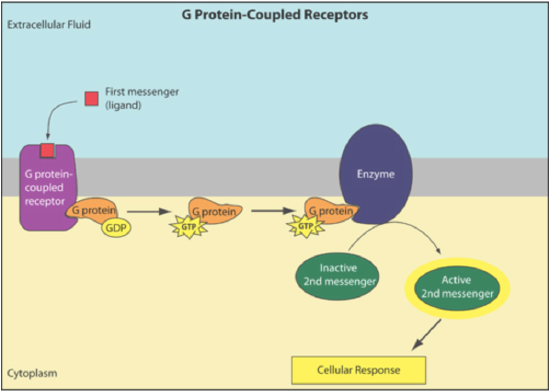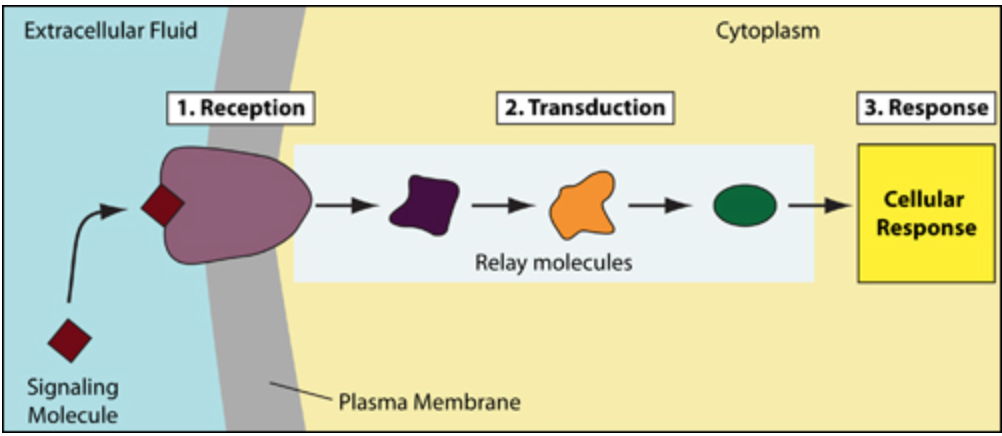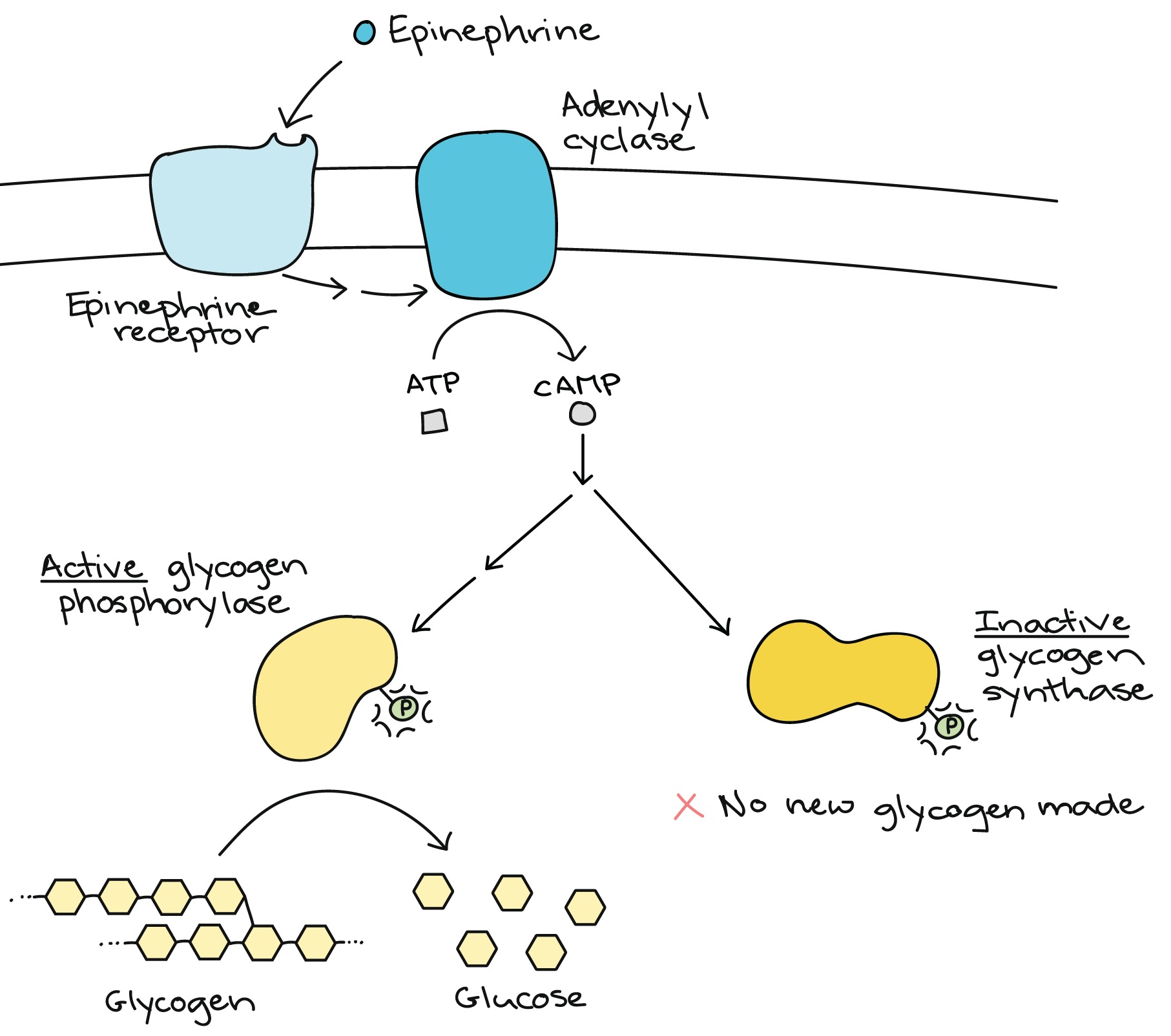Which Best Describes a Signal Transduction Pathway
Signal transduction is the process by which a chemical or physical signal is transmitted through a cell as a series of molecular events most commonly protein phosphorylation catalyzed by protein kinases which ultimately results in a cellular response. In a certain signal transduction pathway the binding of an extracellular molecule to a cell-surface protein results in a rapid increase in the concentration of cyclic AMPAMP inside the cell.

Autonomic Nervous System Nervous System Sympathetic System
Which of the following best describes how the response would be affected if the molecular changes that occur during a signaling pathway lasted for a prolonged period.

. Target proteins are phosphorylated. The model for the action of Epinephrine is shown below. Inactivation mechanisms would be triggered before the pathway could be completed.
2Protein kinases are activated. Epinephrine is used as a sample messenger to trigger the release of glucose from cells in the liver. A cascade of events or biochemical changes within the cell.
Signal transduction is usually a pathway of several steps. For more detailed reviews see refs. 3A signal molecule binds to a receptor.
These form the nucleus for the assembly of a signal transduction particle that is the starting hub of the various intracellular signaling cascades. Here well look at the general characteristics of intracellular signal transduction pathways as well as some relay mechanisms commonly used in these pathways. O receptors that initiate biochemical changes accomplish this either by intrinsic enzymatic activities within the receptor itself or by activating intracellular messenger.
When the signaling molecule binds the receptor it changes the receptor protein in some way. Which of the following demonstrates negative feedback by the endocrine system. Epinephrine also known as adrenaline or adrenalin is a hormone and a neurotransmitter.
In signal transduction phosphatases _____. The endocrine system incorporates feedback mechanisms that maintain homeostasis. The chains of molecules that relay signals inside a cell are known as intracellular signal transduction pathways.
For the greatest advantage of multiple steps in a transduction pathway is. 10 is beyond the scope of this review. A detailed inventory of all the signaling proteins involved in insulin signal transduction pathways Fig.
Based on the information provided which of the following best describes the role of insulin in this liver cell signal transduction pathway. 4Target proteins are phosphorylated. The activated EGFR triggers a signal transduction pathway which leads to increased frequency of cell division.
Which of the following best describes a signal transduction pathway. Protein kinases are activated. Each relay molecule in the signal transduction pathway changes the next molecule in the pathway.
Signal transmission is caused either by. A signal molecule binds to a receptor. It acts as a ligand.
The signal-receptor complex activates a G protein. Which of the following best describes the component that metformin represents in a signal transduction pathway that regulates glucose production in the liver. When a growth factor binds to EGFR the receptor is activated.
Which best describes the way in which phosphorylation affects enzyme activity. Signal Transduction Pathways. This change initiates the process of transduction.
Simplified representation of major signal transduction pathways in mammals. 1The signal-receptor complex activates a G protein. In a signal transduction pathway fine tuning of the cellular response occurs in several steps.
The G-Protein adenylyl cyclase cAMP and protein kinases are all used as illustrative examples of signal. All of the following are enzymes involved in the signal. A binding of a signal molecule to a cell protein B catalysis mediated by an enzyme C sequence of changes in a series of molecules resulting in a response D binding of a ligand on one side of a membrane that results in a change on the other side E the cells detection of a chemical or mechanical stimulus.
After transduction most of the sensory neural information passes through which structure. QUESTIONS Phosphorylation of enzymes is a common mechanism used by signal transduction pathways to regulate the activity of enzymes. The cyclic AMPAMP binds to and activates cytosolic enzymes that then activate other enzymes in.
O Phosphorylation affects the binding of allosteric effectors to enzymes resulting in altered activity. Signal Transduction transmission of molecular signals from outside the cell into the cell via cell-surface receptors. Paul Andersen explains how signal transduction pathways are used by cells to convert chemical messages to cellular action.
Which of the sequences below best describes the sequential steps numbered 1-5 in a signal transduction pathway that utilizes a G protein-coupled receptor. In yeast signal transduction a yeast cell releases a mating factor which _____. Which of the sequences below best describes the sequential steps numbered 1-5 in a signal transduction pathway that utilizes a G protein-coupled receptor.

Signal Transduction Biology Libretexts

Signal Transduction Biology Libretexts


0 Response to "Which Best Describes a Signal Transduction Pathway"
Post a Comment